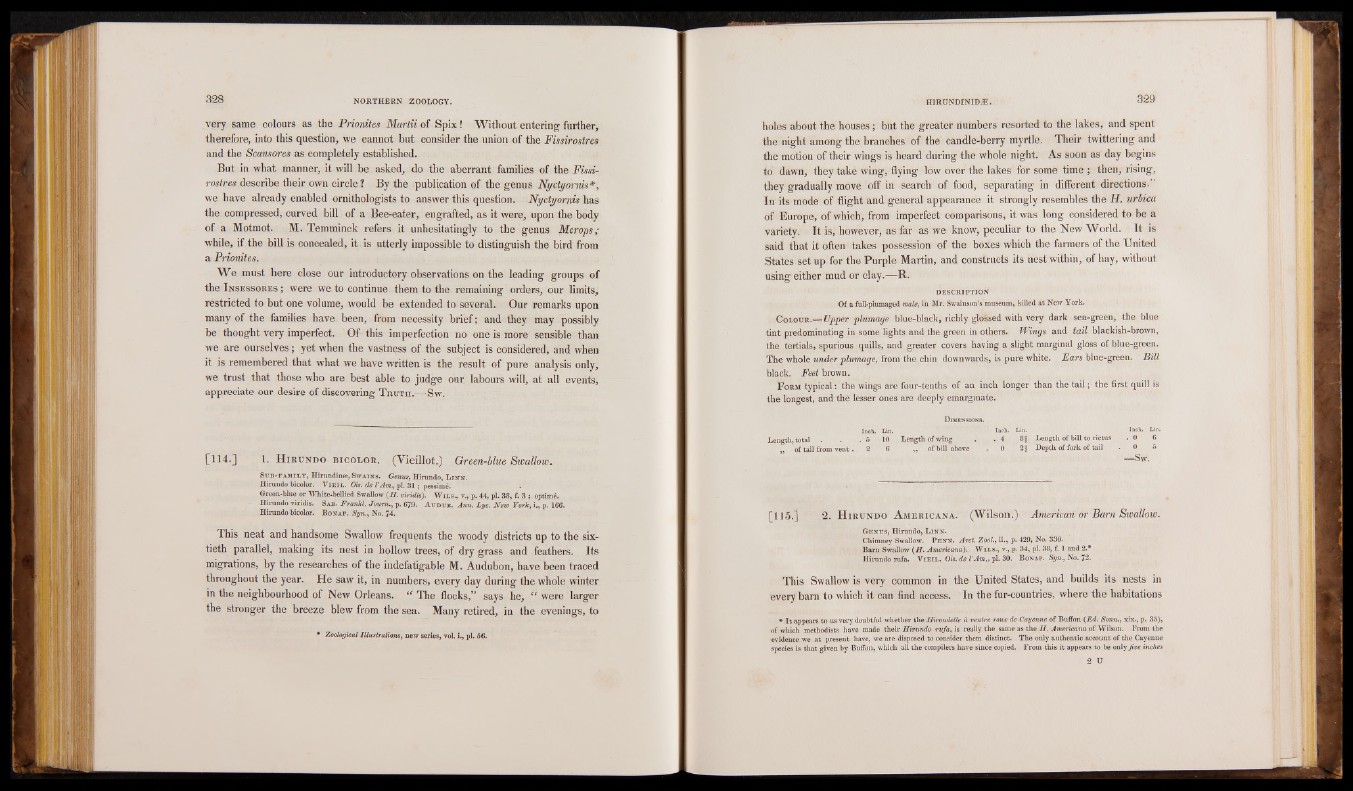
very same colours as the Prionites Martii of Spix! Without entering further,
therefore, into this question, we cannot but consider the union of the Fissirostres and the Scansores as completely established.
But in what manner, it will be. asked, do the aberrant families of the Fissirostres
describe their own circle ? By the publication of the genus Nydyornis*,
we have already enabled ornithologists to answer this question. N yctyomis has
the compressed, curved bill of a Bee-eater, engrafted, as it were, upon the body
of a Motmot. M. Temminck refers it unhesitatingly to the genus Merops;
while, if the bill is concealed, it is utterly impossible to distinguish the bird from a Prionites.
We must here close our introductory observations on the leading groups of
the Insessores ; were we to continue them to the remaining orders, our limits,
restricted to but one volume, would be extended to several. Our remarks upon
many of the families have been, from necessity brief; and they may possibly
be thought very imperfect. Of this imperfection no one is more sensible than
we are ourselves; yet when the vastness of the subject is considered, and when
it is remembered that what we have written is the result of pure analysis only,
we trust that those who are best able to judge our labours will, at all events,
appreciate our desire of discovering Truth.—Sw.
[114.] 1. H irundo bicolor. (Vieillot.) Green-blue Swallow.
Su b -f a m il y , Hirundinse, Sw ain s. Genus, Hirundo, L in n .
Hirundo bicolor. V i e i l . Ois. de VAm., pi. 3 1 ; pessime.
Green-blue or White-bellied Swallow (H. viridis). W ils., v., p. 44, pi. 38, f. 3 ; optime.
Hirundo viridis. Sab. Franlcl. Jouni., p. 679. A u d u b . Ann. Lye. New York, i., p. 166.
Hirundo bicolor. Bonap. Syn., No. 74.
This neat and handsome Swallow frequents the woody districts up to the sixtieth
parallel, making its nest in hollow trees, of dry grass and feathers. Its
migrations, by the researches of the indefatigable M. Audubon, have been traced
throughout the year. He saw it, in numbers, every day during the whole winter
in the neighbourhood of New Orleans. The flocks,” says he, “ were larger
the stronger the breeze blew from the sea. Many retired, in the evenings, to
Zoological Illustrations, new series, vol, i., pi. 66.
holes about the houses ; but the greater numbers resorted to the lakes, and spent
the night among the branches of the candle-berry myrtle. Their twittering and
the motion of their wings is heard during the whole night. As soon as day begins
to dawn, they take wing, flying low over the lakes for some time ; then, rising,
they gradually move off in search of food, separating in different directions.”
In its mode of flight and general appearance it strongly resembles the H . urbica of Europe, of which, from imperfect comparisons, it was long considered to be a
variety. It is, however, as far as we know, peculiar to the New World. It is
said that it often takes possession of the boxes which the farmers of the United
States set up for the Purple Martin, and constructs its nest within, of hay, without
using either mud or clay.—R.
DESCRIPTION
Of a full-plumaged male, in Mr. Swainson’s museum, killed at New York.
Colour.-— Upper plumage blue-black, richly glossed with very dark sea-green, the blue
tint predominating in some lights and the green in others. Wings and tail blackish-brown,
the tertials, spurious quills, and greater covers having a slight marginal gloss of blue-green.
The whole under plumage, from the chin downwards, is pure white. Ears blue-green. Bill
black. Feet brown.
Form typical: the wings are four-tenths of an inch longer than the tail; the first quill is
the longest, and the lesser ones are deeply emarginate.
Dimensions.
Inch. Lin. ' Inch. Lin. Inch. Lin.
Length, total . . . 6 10 Length of wing .. . 4 8§ Length of bill to rictus . 0 6
of tail from vent. 2 6 „ of bill above . 0 2g Depth of fork of tail . 0 5
—Sw.
[115.] 2. H irundo Americana. (Wilson.)'" American or Bam Swallow.
Ge n u s , Hirundo, L in n . Chimney Swallow. P e n n . Arct. Zool., ii., p. 429, No. 330.
Barn Swallow (H. Americana). W il s ., v., p. 34, pL 38, f. 1 and 2.*
Hirundo rufa. V i e i l . Ois. de VAm., pi. 30. B onap. Syn., No. 72.
This Swallow is very common in the United States, and builds its nests in
every barn to which it can find access. In the fur-countries, where the habitations
* It appears to us very doubtful whether the Hirondelle a ventre route de Cayenne of Buffon {Ed. Sown., xix., p. 35),
of which methodists have made their.Hirundo rufa, is really the same as the H. Americana of Wilson. From the
evidence we at present have, we are disposed to consider them distinct. The only authentic account of the Cayenne
species is that given by Buffon, which all the compilers have since copied. From this it appears to be only ./we inches